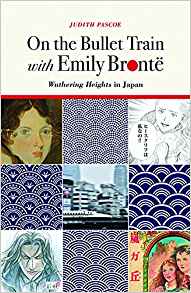
Emily Bronte’s only novel “Wuthering Heights,” set in the moors of northern England in the late 18th century, has long been staple reading in Japan.
The story of Catherine Earnshaw and her adopted brother Heathcliff, has spawned over 20 Japanese interpretations since the novel was first translated into Japanese by Yasuo Yamamoto in 1932. Japanese language renditions include manga series (including a yuri lesbian-themed manga by Takako Shimura), stage productions, a children’s book version and a contemporary adaptation of the classic story told by Minae Mizumura in “A True Novel” (“Honkaku Shosetsu”) which sets “Wuthering Heights” in postwar Japan. With the translation of this Japanese story into English (by Juliet Winters Carpenter), the drama crosses cultural and geographical boundaries that give it an enduring global quality.
So, what is it that endears Emily Bronte’s novel to the Japanese people? I traveled to Florida State University to find out.

The campus, situated in the capital of Tallahassee in the northwest panhandle, lies smothered in the embrace of giant canopied trees that drip heavily with thick strands of Spanish moss the size and diameter of boa constrictors. Among this haunting graveyard-like beauty is a cluster of stately red brick buildings, one of which houses the Department of English.
Inside sits the esteemed professor of 18th- and 19th-century English literature Judith Pascoe. But the petite woman with large horn-rimmed glasses admits that she struggled for years to understand the ostensible brilliance of “Wuthering Heights.”
“I just didn’t get it,” she tells me, although as a graduate student she sailed through the works of Bronte sister Charlotte’s epic “Jane Eyre.”
Keep in mind that Emily wrote her novel in less than a year, a single-minded pursuit carried out among the constant disruptions of living in the Yorkshire moors of the mid-1840s. Elizabeth Gaskell recounts in her biography of Charlotte Bronte that the noisy modern railway churning through the countryside — with no obvious regard for aspiring female novelists — was unsettling. Then there was the much-anticipated visits by the postman, who might bring letters the sisters would fancy responding to. It’s enough to yearn for the days of such “interruptions.” But still the sisters managed to churn out admirable volumes of literature.

In contrast, Pascoe set out on an eight-year study to find out why, in a country so culturally disparate as Japan, the story of “Wuthering Heights” endures. Her adventure encompassed four visits to the country, commencing with a stint as a Fulbright teacher of American literature at Japan Women’s University in Tokyo. As ambitious as this is, Pascoe set the bar even higher by determining to learn the Japanese language so she could read the novel (called “Arashigaoka” in Japanese) and its various interpretations in the local language.
The result of her peregrination, in which she interrogates casual readers about their attraction to the novel and interviews key figures involved with the various renditions, is chronicled in her book “On the Bullet Train with Emily Bronte.” She weaves her own narrative of attempting to understand Japan, the Japanese and the Japanese language together with her genuine perplexity at the popularity of Emily Bronte’s novel, resulting in a highly readable and enjoyable little book. A Guggenheim Fellowship in nonfiction allowed her to finish the project, which documents this journey flanked by her own cast of characters: her two daughters who devour manga and attend Japanese schools, and a very patient husband who feigns interest whenever Pascoe has a “Wuthering Heights” epiphany. Within the first few pages of the book, the reader is speeding along on the bullet train at 300 kph in the same row of seats as Judith Pascoe and Emily Bronte.
Anyone who has seen the original “Wuthering Heights” movie by William Wyler (the 1939 black-and-white version starring Laurence Olivier as Heathcliff and Merle Oberon as Catherine), will remember a fairly irreproachable love story sans the overdoses of violence, revenge and animal cruelty that existed in the original novel.
The scariest part of the movie for me was the sudden and constant violent storms that plagued the Earnshaw’s property. “Here’s this violent, nasty novel that has all this viciousness in it, so in that way is almost anti-romantic,” Pascoe says. While the Hollywood version played down these scenes, the Japanese versions embraced the more sordid episodes.
Pascoe relates that she obtained her first real sense of the all-yielding power of “Wuthering Heights” here in Japan after meeting Miyako Koshiro, the woman who played Heathcliff in the first Takarazuka stage play (1969) and who described the role as transformative. It was the role that set her on the path to stardom.
Pascoe forges on to interview Tetsunori Ota, director of the second Takarazuka theater production of “Arashigaoka” (1997-98). “He placed Bronte in a Japanese literary context,” she tells me as the sky suddenly darkens and rain starts pelting the window of her office. As the wind starts howling, I imagine the Spanish moss slinging itself across the campus quad.

Ota introduced Pascoe to the works of Chikamatsu Monzaemon, the dramatist who explored themes of double suicide in bunraku puppet theater and kabuki productions. In such trysts, the two lovers become one another. “These lovers have to kill themselves in order to fulfill their love in heaven,” Ota had explained to her.
In the first scene of the novel, Catherine’s ghost revisits Wuthering Heights. While the specter that appears presents a frightening scene in the original novel and the Wyler movie, Pascoe discovers a cultural disparity: Ghosts are not always scary in Japan. She relates how in Mizumura’s “A True Novel,” a ghost dons a summer kimono and returns during the o-Bon festival of the dead, a time when most Japanese people are welcoming spirits back home.
Yoko Hanabusa, who has published a manga version of “Wuthering Heights,” helps Pascoe uncover more cultural innuendo: that a romance in a faraway foreign country can evoke a sense of longing among Japanese women.
In addition to a romance, the Japanese may also see a multiple family saga where Catherine and the urchin Heathcliff engage in a genuine love that can never come to fruition in real life because of class differences. Catherine ends up marrying Edgar Linton, a man who will provide her with the wealth she needs to live the life of a society woman. I suspect that Japanese readers can also identify as it is still common to value wealth and status over true love when it comes to marriage in Japan.
As our conversation comes to an end, so does the wicked weather outside. As we move on to less tumultuous subjects, sunshine streams its approval through doctor Pascoe’s office window.
A previous version of this article appeared in the Japan Times on March 25, 2018.
